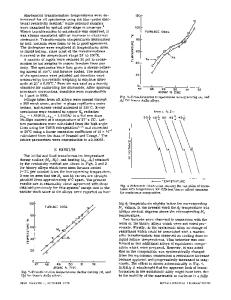Plastic deformation of polycrystalline binary and ternary beta brass alloys
- PDF / 1,788,556 Bytes
- 8 Pages / 613 x 788.28 pts Page_size
- 104 Downloads / 337 Views
3
1 I
|
I
I
]
440 450 460 470 Temperature (~ 1
430
Fig. 1 - - T e m p e r a t u r e d e p e n d e n c e of the yield s t r e s s n e a r T c .
540
530
B. Yield Strength The 0.2 pct offset yield s t r e s s was determined for each alloy over the temperature range 25~ to 300~ These results are shown in Fig. 4(a). Increasing the zinc content in binary alloys resulted in a decrease in strength while manganese and nickel additions both strengthened beta b r a s s . However, manganese was the more effective strengthener. All of the alloys exhibited a peak in the yield s t r e s s as a function of t e m p e r ature. Compared to the binary alloys, manganese increased the temperature of the peak while nickel lowered it. Contrary to previous results, 2 the zinc content of binary alloys did not appear to affect the temperature of the peak. In order to take into account the different ordering temperatures of the alloys, the yield s t r e s s data also were plotted as a function of the ratio of test temperature to the alloy's critical temperature for ordering, T c. The normalized temperature dependences of the yield s t r e s s for binary and t e r n a r y alloys in Fig. 4(b) show the same relative effect of alloy com756-VOLUME 5, MARCH 1974
o ~ 45 w/o Zn a ~ 4 8 w / o Zn
520
Ni
510
500
~
490
480
4e( (~- 41
E
I~ 4 4 0 . ~ 430 420 4~0 a
.~ 400 (.) 390 38C 370
I
2
3
4
5
WEIGHT %TERNARY SOLUTE
Fig. 2 - - C o m p o s i t i o n d e p e n d e n c e of T c . METALLURGICAL TRANSACTIONS
2'99 I 2.9e
\\
X"\\ \N n
in48Zn
2.97
:'~
\\ \ Ni in \ \\ J 48Zn\\ \
/Mnin45Zn
2.95 LU CI k-. k-,,r 2.94 ..J
""
I
I
I
w/oTERNARYSOLUTE Fig. 3--Composition dependence of the lattice parameter. e n c e s b e t w e e n the s t r a i n h a r d e n i n g r a t e s of the a l l o y s d e c r e a s e d at any t e m p e r a t u r e ; that is, m a n g a n e s e h a s an a p p r e c i a b l e effect only upon the i n i t i a l p o r t i o n of the s t r e s s - s t r a i n c u r v e . D. D u c t i l i t y All of the a l l o y s f a i l e d in a d u c t i l e m a n n e r in a i r at 25~ and above. The d u c t i l i t i e s e x p r e s s e d a s p c t RA a r e shown in Fig. 6 a s a function of t e m p e r a t u r e . Duct i l i t i e s a p p r o a c h e d 99 p c t f o r e a c h a l l o y at t e m p e r a tures slightly above their strength peak. Increasing t h e z i n c content of b i n a r y b e t a b r a s s i n c r e a s e d the d u c t i l i t y b y about 10 p c t RA at a l l t e m p e r a t u r e s below 150~ Additions of n i c k e l and m a n g a n e s e to a 48 p c t Zn a l l o y d e c r e a s e d the d u c t i l i t y by about 10 p c t RA in t h i s t e m p e r a t u r e r a n g e . In addition, the t e m p e r a t u r e d e p e n d e n c e s of the d u c t i l i t y f o r the m a n g a n e s e a l l o y s e x h i b i t e d an a r r e s t at 75~ to 100~ b e l o w t h e i r s t r e n g t h p e a k s . T h i s a r r e s t p e r s i s t e d until the t e m p e r a t u r e of the p e a k was r e a c h e d and the d u c
Data Loading...











